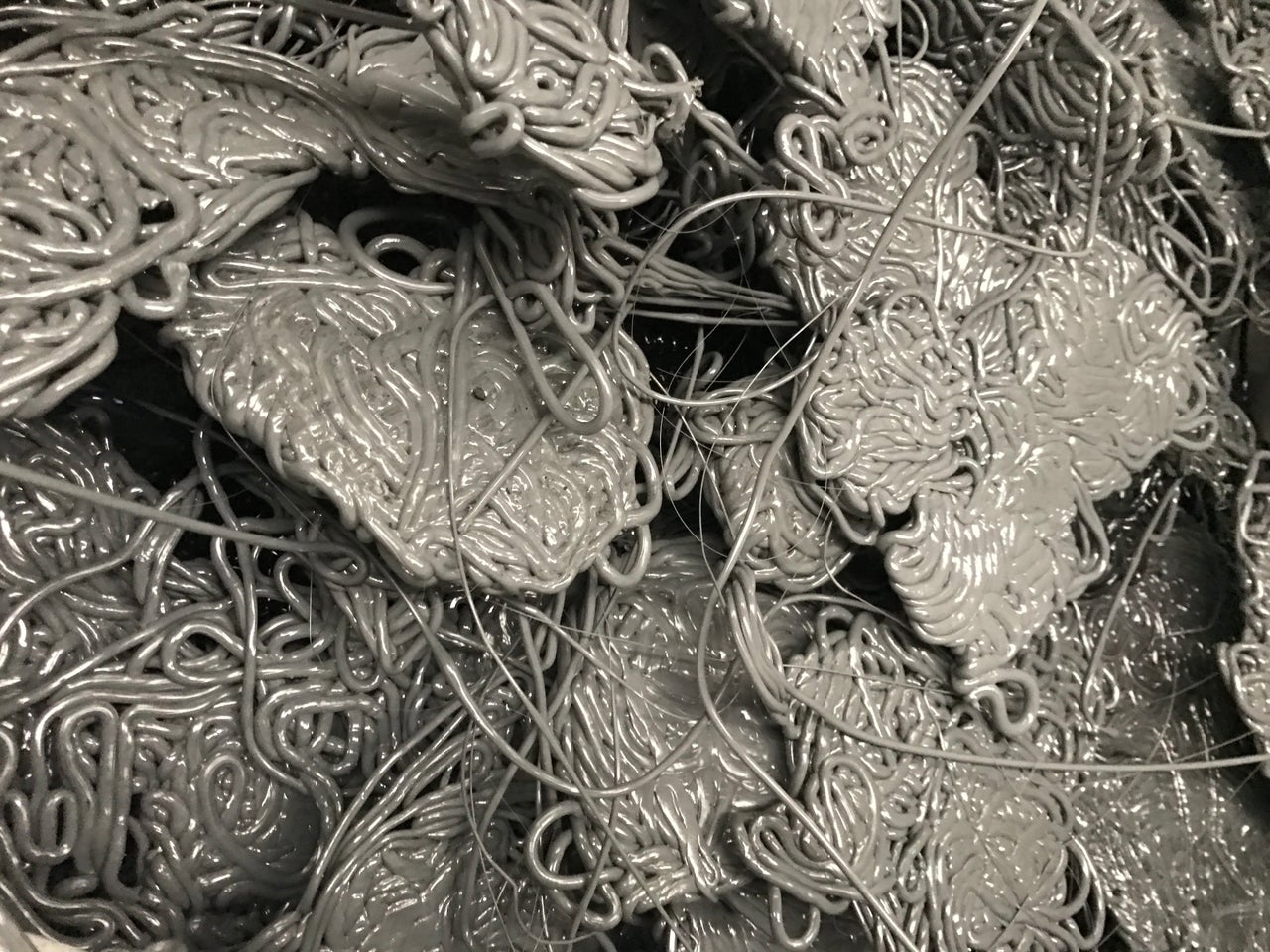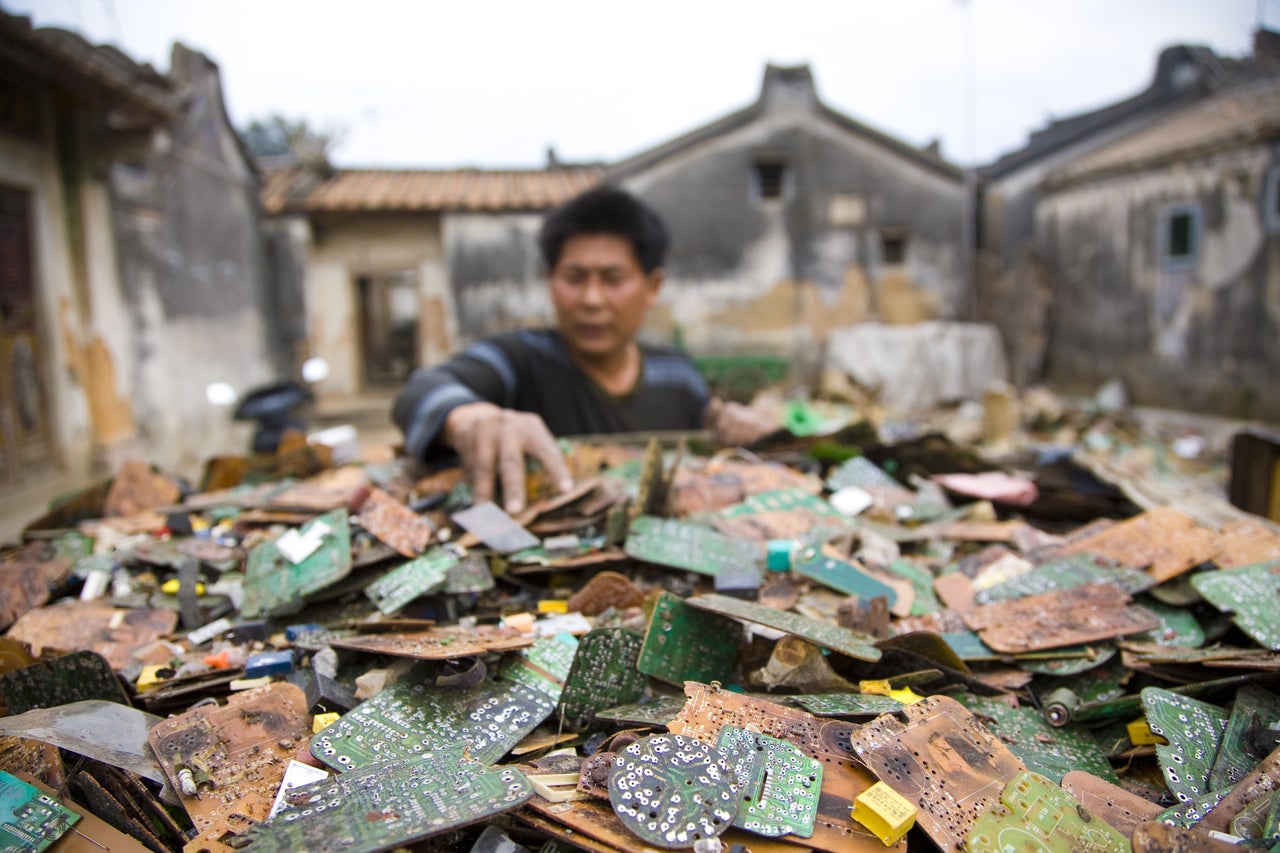SHANGHAI — In a sparse and sprawling factory complex on the outskirts of Shanghai, thousands of tiny plastic resin pellets are shivering along narrow conveyor belts, ready to be transformed into something new.
The dark pellets are unremarkable at first glance, resembling any plastic granule used for manufacturing. But follow their journey from consumer to conveyor belt, and their significance — particularly for the world’s burgeoning electronic waste crisis, and what companies and their customers can do to address it — becomes clear.
The pellets are made from a blend of virgin plastic and the recycled product of some of the millions of pounds of e-waste that Dell, the American computer giant, collects from consumers every year.
In 2017, Dell said it gathered more than 177 million pounds of used electronics from people in 83 participating countries and territories. If you were one of these consumers, this Chinese factory ― run by Dell’s Taiwanese recycling partner, Wistron Corp. ― might be where parts of your old laptop or PC ended up.
Here, at Wistron’s factory, plastic recycled from e-waste is used to make parts for new Dell computers and laptops in a process known as “closed-loop recycling” ― essentially the reusing of a recycled product to manufacture new versions of the same product. In this case, it’s the recycling of old electronics to make new.
Dell is among a growing group of technology companies that have, in recent years, embraced this type of recycling ― in part to address the ballooning problem of e-waste worldwide. Sustainability experts say closed-loop recycling, if carried out effectively at a large scale, could go a long way in mitigating the global crisis.
Every year, the planet generates some 50 million tons of e-waste — ranging from laptops and mobile phones to batteries and children’s toys ― and that number is expected to swell as populations grow and access to electronics increases. By 2021, the amount of e-waste generated globally is predicted to surpass 57 million tons.
E-waste is now the world’s fastest-growing waste stream, according to a recent report in The New York Times. That growth has not just stoked concerns about e-waste’s potential health and environmental impacts, but has also fueled interest in economic opportunities.
Computers and phones contain materials that can be salvaged and repurposed, like plastic and metals like gold and silver. In 2016, the estimated value of recoverable raw materials in discarded e-waste was more than $55 billion globally, according to a United Nations University report. As the researchers pointed out, that’s “more than the 2016 Gross Domestic Product of most countries in the world.”
As it stands, however, only a fraction of the world’s e-waste gets recycled. Shantanu Bhattacharya, a supply chain expert and professor at Singapore Management University, told HuffPost that only about 15 percent to 25 percent of the world’s e-waste is recycled or reused.
The majority of e-waste, which can also contain dangerous substances like lead, mercury, arsenic and flame retardants, ends up in landfills or is incinerated, causing toxic materials to contaminate land, water and air. In the U.S., e-waste makes up just 2 percent of landfill trash, but represents 70 percent of all hazardous waste in landfills.
There is clearly room ― and need ― for improvement. Sustainability advocates say a “circular economy” model could help by reusing and recycling discarded electronic scrap to make new products, instead of mining the planet for already-overexploited raw materials while creating mountains of waste.
Closed-loop recycling is a circular economy concept that tech companies like Dell, Hewlett-Packard and Apple have increasingly shown an interest in.
Dell, which describes itself as the world’s largest technology recycler, is a closed-loop pioneer in the tech industry. In 2014, the company unveiled a new computer system made partly of certified closed-loop recycled plastics ― an industry first. A spokeswoman told HuffPost last week that the company now makes over 125 products with closed-loop recycled plastic. Since 2014, Dell has used over 21 million pounds of closed-loop plastics in their products, she said.
More than 30 percent of the plastic in the e-waste collected by Dell gets recycled through the closed-loop process. The rest goes to downstream recyclers to create recycled plastics for other electronics like home appliances and refrigerators, the company rep said. A “small percentage” that cannot be recycled is disposed of in waste-to-energy plants, according to the spokeswoman. The company did not reveal the exact amount that gets disposed of in this manner.
Dell this year expanded its closed-loop program to include gold mined from the e-waste it collects. The company is now the first PC manufacturer to use recycled gold from e-waste in its products. Dell also partnered with actress Nikki Reed this year to create a limited-edition jewelry collection made from gold mined from recycled computer motherboards.
Hewlett-Packard, another industry leader in this area, has been perfecting its own closed-loop recycling system for years. It was the first company to recycle ink cartridges in a closed-loop system. In 2017, it introduced the world’s first printer made with 10 percent closed-loop recycled plastic.
Lenovo said last year that it had begun developing closed-loop recycling materials with the aim of using them in select products. Also last year, Apple made waves when it announced its goal to move toward a 100-percent closed-loop supply chain.
“It sounds crazy, but we’re working on it,” the company said in its annual Environmental Responsibility report. “One day we’d like to be able to build new products with just recycled materials, including your old products.”

With these recycling initiatives, tech companies are helping to fill a gaping need in the market. In the U.S., many municipalities can’t afford to recycle e-waste. A lot of it, therefore, ends up getting trashed or shipped to developing nations like China, Thailand and Kenya, where e-waste either gets dumped or dismantled by informal recyclers and backyard businesses in unregulated and often-hazardous conditions.
Closed-loop recycling could, therefore, be a win-win for companies and the planet.
Maria Besiou, an expert on sustainable supply chain management, said closed-loop recycling is a “critical step” that producers and consumers of electronic products should take.
It’s a “very good solution,” Besiou, a professor of humanitarian logistics at Kühne Logistics University in Hamburg, Germany, told HuffPost over the phone this month.
Challenges, however, remain for closed-loop e-waste recycling, said Besiou. The obstacles have limited the effect of these recycling systems on the e-waste problem.
Consumers, Besiou said, are a major kink in the system: People simply don’t recycle their e-waste as often or as quickly as they should.
“Imagine you have a smartphone that you no longer want,” Besiou said. “What will you do with it? Most people will keep it in a drawer just in case they need it later on, or give it to a friend or family member.”
“Many people don’t recycle their electronics at all, or even if they do ― by the time they actually recycle it, it’s so old and degraded that it’s not what producers want,” Besiou continued. “That means, companies can’t collect the right quality and quantity” of e-waste to ensure their closed-loop systems are working optimally.
Consumer perspectives about e-waste and sustainability appear to be changing for the better, however, according to Oliver Campbell, director of Dell worldwide procurement and packaging.
“Consumers are now thinking differently about sustainability,” Campbell said in an earlier interview with HuffPost, noting that shoppers seem to increasingly care how products are made and what they’re made of.
“What’s beautiful and what’s desirable is changing. It’s not just about the unboxing experience or the attractiveness of the product itself, but people are now asking, ‘How do I feel when I use this plastic? How do I feel when I have to dispose of it?’” Campbell said.
Besiou said companies also need to start designing products that aren’t just recyclable in a closed-loop system, and that last longer, so less waste is generated in the first place. And consumers should resist the temptation to replace their perfectly usable electronics with the coolest new products, reducing their own consumption, too.
“Everybody in the supply chain ― from producers, recyclers, governments and consumers ― everyone’s trying to push responsibility [for e-waste] from one stakeholder to another,” Besiou said. “But the problem is, this affects the lives of everybody. Everyone needs to get involved.”
This article has been updated to include details about Dell’s e-waste recycling and disposal program.
